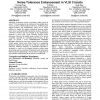Free Online Productivity Tools
i2Speak
i2Symbol
i2OCR
iTex2Img
iWeb2Print
iWeb2Shot
i2Type
iPdf2Split
iPdf2Merge
i2Bopomofo
i2Arabic
i2Style
i2Image
i2PDF
iLatex2Rtf
Sci2ools
DAC
2005
ACM
2005
ACM
Constraint-aware robustness insertion for optimal noise-tolerance enhancement in VLSI circuits
Reliability of nanometer circuits is becoming a major concern in today’s VLSI chip design due to interferences from multiple noise sources as well as radiation-induced soft errors. Traditional noise analysis/avoidance and manufacturing testing are no longer sufficient to handle the dynamic interactions between various noise sources and unpredictable operational variations. Therefore, “robustness insertion” has been adopted as the supplementary approach to ensure high circuit reliability through on-line protections. However, the related design overhead is not always acceptable, especially for cost/timing-sensitive designs. In this paper, we present a novel “constraint-aware robustness insertion” methodology protect the sequential elements in digital circuits against various noise effects. Based on a configurable hardening sequential cell design and an efficient sequential cell robustness estimation technique, an optimization algorithm is developed to search for the optimal pr...
| Added | 13 Oct 2010 |
| Updated | 13 Oct 2010 |
| Type | Conference |
| Year | 2005 |
| Where | DAC |
| Authors | Chong Zhao, Yi Zhao, Sujit Dey |
Comments (0)

